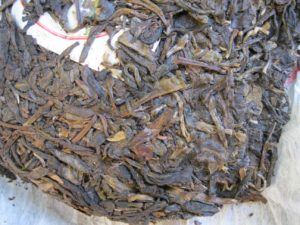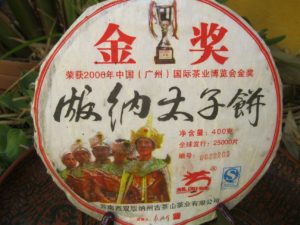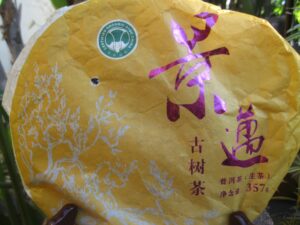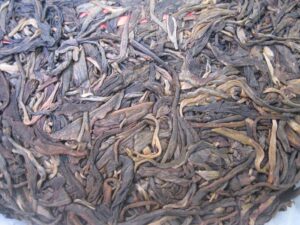Shocking Puerh Changes

Shocking Puerh Changes relates the on-going observations of the Puerh Junky with his pre-2016 purchases. Specifically, it involves the dangers of classifying productions, which are wont to transform into an entirely different category. It is also part of a saga of discovering erstwhile duds were nothing of the sort, but processed in such a way where they only have come into form after a great deal of time. Let’s begin.
Shifting Puerh Class
The ’07 Prince of Vanilla came into the Puerh Junky’s possession in ’15. It hails from the Longyuan TF, which produces an awful lot of tea, many with super fancy wrappers. In the year of its incarnation, ’06, the PoV won some type of metal at some competition that was essentially ignored upon acquisition. The wrapper captures a theme of a continued Dai/Thai tradition thus comprising a thematic “fit.” Compression is one of the most noticeable features of the cake. Whereas most Menghai productions from this era have been machine pressed with serious zeal, the PoV is quite moderately pressed.
Nothing impresses more than the ability of competition tasters. Over the years, it is hard to say any thing had particularly stood out about the PoV and for copetition tasters to detect award-winning traits hot off the press boggles the mind. In one missive, I mentioned that Prince of Vanilla made for good bowl drinking and that the qi was stout, a great firm drink in the Tobacco Class for the morning. At one time, there was a vanilla note, which earned it its name, but after some time faded residing rather humbly in the Tobacco Class most distinguished by its wrapper.
As such, it never garnered any special storage attention and could said to have been relegated to quasi-purgatory treatment. Special attention means more humidity and purgatory means getting whatever humidity possible, which isn’t a whole lot. This could prove positively disastrous in the desert, but Los Angeles isn’t exactly a desert climate given the famous marine layer that adds a bit of humidity to the air for about three of the four seasons.
As of the summer of ’22, the Prince of Vanilla’s Tobacco Class days are very behind it. It is now a Fruit Class bomb. It’s not like the Thick Zen where there are just fruit notes. No, it is screaming blueberry, a taste which lingers and lingers long after done drinking. It’s as though this is the material from which the mercurial Merlot was taken. Merlot is a ripe which was originally going to be called Crunch Berries because it was so fruity but then settled into something more like Merlot before shifting back into to a voluble fruity expression. . . with more qi. It seems sometimes that consistent dry storage will develop this fruit character, instead of strong camphor and tree roots. The storage is certifiably dry but it isn’t in the least dry tasting. That occurs when storage is too dry and too hot, which in any event result in different notes. Here, nothing about the PoV is dry. It’s super summer fun.
Jingmai Puerh Awakens
Another ’15 acquisition was a Jingmai with a stunning wrapper from a now either defunct or reorganized outfit called Mountain Top TF. The fate of such a factory is quite telling. To wit: the ’09 Jingmai is only now starting to show signs of promise in ’22. A new factory faces a serious uphill batter for survival if their processing required waiting a good 15 years before coming into form. This is a battle that Mountain Top appears to have lost, but there’s still its offerings for evaluation and enjoyment.
Perhaps most surprising about this Jingmai was its utter absence of the signature Jingmai florality. Youth and processing notwithstanding, Jingmai are still expected to possess a floral character. Without any particular character or floral expression, this production was nothing short of a major dud, especially given its exquisite wrapper and very careful pressing. As such, it was set aside and essentially given the purgatory treatment: dry and given little if any fuss.
The July ’22 tasting proved surprising. There is a hint of flowers starting to emerge amidst a very sweet broth. It’s hard to imagine how such tastes and aromas age into a production, but this is what makes puerh aging so interesting. Also shocking is the virtual absence of colour in such an old production. By all accounts, I would have guessed that this was a ’20 Lincang processed for young consumption, the exact opposite of the facts.
The caste of the broth stays this colour throughout. There may be a hint of pink in there which is supposed to a mark of the absolute best. It could also be from the time of day the photo was taken. I paid more attention to whether the floral note would express more strongly, how long the sugariness would continue, and whether the broth would darken up or go through a cloudy stage than the nature of the hue itself. It never went through a cloudy stage nor did it get darker. The richness and sugar start to fade in the 6th and 7th infusions. Clearly its most humbling feature involves the colour, as a typical barometer of age. Curve balls of this sore make the Puerh Junky all the more apprehensive in doubting some age claims.
The remaining cakes were resting in more humid climes for a few months, but there’s a measure of storage orchestration with which I’m currently contending, so they’re back to purgatory for at least the next week. The Jingmai will be sampled again at the end of the summer. I’ll be particularly interested in how long it lasts and whether the floral note continues to develop, as I’m finding with the Bulang Shengtai.





